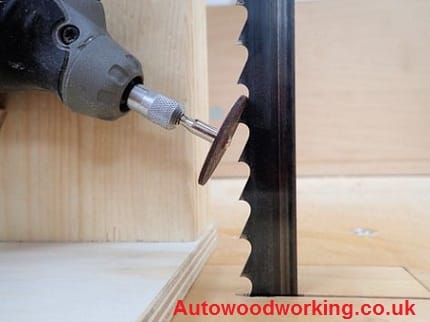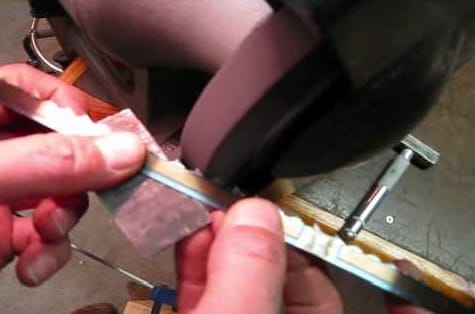As an Amazon Associate, I earn from qualifying purchases.

Bandsaws are one of the most versatile tools in a woodworker’s arsenal, but dull blades can make them almost useless. Dull blades can cause poor cuts, overheating, and even damage to the blade itself. In this article, we’ll guide you through the steps to sharpen bandsaw blades, so you can keep your saw running smoothly and producing high-quality cuts.
Contents
What Is A Bandsaw Blade?
Before we dive into how to sharpen bandsaw blades, let’s first understand what a bandsaw blade is. A bandsaw blade is a long, thin blade with teeth along the edge. It is used in a bandsaw machine to make precise cuts in wood, metal, and other materials. Bandsaw blades come in a variety of widths, lengths, and tooth configurations to suit different applications.
When To Sharpen Bandsaw Blades?

It’s essential to keep an eye on the quality of your bandsaw cuts to determine when it’s time to sharpen the blade. Dull blades will cause rough cuts, burning, and excessive sawdust. You may also notice the blade wandering, which indicates it is not cutting straight. If you’re experiencing any of these issues, it’s time to sharpen your bandsaw blade.
Types Of Bandsaw Blade Teeth
Before sharpening your bandsaw blade, it’s important to understand the different types of teeth. The type of tooth will affect the blade’s cutting speed, precision, and durability.
Regular Tooth
The regular tooth blade has teeth that are evenly spaced apart, with each tooth having the same height and shape. Regular tooth blades are suitable for general-purpose cutting of wood and other soft materials.
Hook Tooth
Hook tooth blades have fewer teeth per inch (TPI) and larger gullets between the teeth. This configuration allows the blade to remove more material and cut faster than regular tooth blades. Hook tooth blades are ideal for cutting thicker materials and resawing.
Skip Tooth
Skip tooth blades have fewer teeth per inch than regular tooth blades, with every other tooth missing. This configuration creates larger gullets between the teeth, which helps remove material and prevent clogging. Skip tooth blades are ideal for cutting softwoods and plywood.
How To Sharpen Bandsaw Blades?

Types Of Sharpening Techniques
There are three types of sharpening techniques: file sharpening, grinding sharpening, and electric sharpening. The type of sharpening technique you choose will depend on the type of blade and the tools you have.
File Sharpening
File sharpening is the simplest and most common sharpening method. It involves using a file to sharpen the teeth of the blade manually. This method is suitable for carbon steel and high-speed steel blades.
Grinding Sharpening
Grinding sharpening involves using a bench grinder to sharpen the teeth of the blade. This method is suitable for carbide-tipped blades.
Electric Sharpening
Electric sharpening involves using an electric sharpener to sharpen the teeth of the blade. This method is suitable for all types of blades.
Steps To Sharpen A Bandsaw Blade
File Sharpening
- Clamp the blade securely in a vise or clamp, with one tooth exposed.
- Use a file guide to hold the file at the correct angle, which is usually between 5 and 10 degrees.
- Use the file to sharpen each tooth individually, moving in one direction only.
- Repeat the process for every other tooth until all teeth are sharpened.
Grinding Sharpening
- Set up the bench grinder and adjust the grinding wheel to the correct angle, which is usually between 25 and 30 degrees.
- Turn on the bench grinder and hold the blade against the wheel, moving it back and forth to sharpen each tooth.
- Repeat the process for every other tooth until all teeth are sharpened.
Electric Sharpening
- Set up the electric sharpener according to the manufacturer’s instructions.
- Place the blade in the sharpener and turn it on.
- Move the blade back and forth through the sharpener to sharpen each tooth.
- Repeat the process for every other tooth until all teeth are sharpened.
Final Steps
Once you have finished sharpening the blade, it is important to check the blade for any damage or cracks. If you find any, it is best to replace the blade. If the blade is in good condition, reattach it to the saw and adjust the tension and tracking as necessary.
Precautions
When sharpening a bandsaw blade, it is important to wear safety glasses and gloves to protect your eyes and hands from debris and sharp edges. Ensure that the blade is securely clamped before sharpening, and always move the file, grinder, or electric sharpener in the same direction as the teeth.
Tips For Bandsaw Blade Maintenance
To keep your bandsaw blade in good condition, it is important to follow some maintenance tips, such as:
- Use the correct blade for the type of material you are cutting.
- Keep the blade clean and free from debris.
- Adjust the tension and tracking of the blade as needed.
- Use a lubricant on the blade to reduce friction and heat.
- Check the blade regularly for damage and cracks.
FAQs
How often should I sharpen my bandsaw blade?
It depends on how often you use the saw and the type of material you are cutting. As a general rule, you should sharpen the blade when you notice a decrease in the quality of the cut.
Can I sharpen a dull carbide-tipped blade?
Yes, you can sharpen a dull carbide-tipped blade using a bench grinder or an electric sharpener.
Is it necessary to remove the blade from the saw before sharpening?
Yes, it is necessary to remove the blade from the saw before sharpening to ensure your safety and to allow for proper cleaning and inspection of the blade.
Can I sharpen a bandsaw blade with a hand-held sharpener?
No, it is not recommended to use a hand-held sharpener to sharpen a bandsaw blade, as it can damage the teeth and compromise the blade’s integrity.
How can I tell if my bandsaw blade is dull?
You may notice a decrease in the quality of the cut, such as rough edges, burning, or difficulty in cutting. You may also hear a loud noise or feel vibrations coming from the saw.
Conclusion
Sharpening a bandsaw blade is a simple process that can improve the quality of your cuts and prolong the life of your blade. By following the steps outlined in this article and using the correct tools and techniques, you can keep your bandsaw blade sharp and in good condition.



